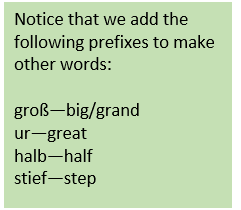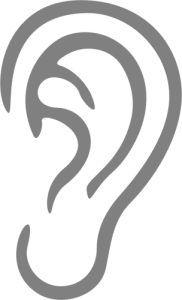8 Section 1-8: Plurals
1–8: Plurals
So far, you have learned that German nouns have a grammatical gender (der, die or das). Now you will learn how to make them plural. In English, we usually add an –s or –es to the end of the word:
- book→books
- computer→computers
- hobby→hobbies
In German, however, there are several different endings to form plurals. You will need to learn the plural form when you learn new words. The dictionary form of German nouns will show letters that come after the noun. These should be added to the word to form the plural.
75-90% of masculine and neuter nouns add -e
- der Tisch, -e→die Tische
- das Papier, -e→die Papiere
- das Heft, -e→die Hefte
- der Filzstift, -e→die Filzstifte
Occasionally, these words will add an umlaut in addition to –e.
- der Stuhl, –¨e→die Stühle
- der Rucksack, -¨e→ die Rucksäcke
75-90% of feminine nouns add –n or –en.
- die Tafel, -n→die Tafeln
- die Uhr, -en→die Uhren
- die Landkarte, –n→die Landkarten
- die Tür→die Türen
- die Tasche→die Taschen
Occasionally, these words will add an umlaut in addition to –n or –en.
- die Maus, -¨e→die Mäuse
- die Wand, -¨e→die Wände
Feminine words ending in –in that denote people also add –en or –n but add an extra –n- between the noun and the plural ending.
- die Professorin, -nen→die Professorinnen
- die Studentin, –nen→die Studentinnen
- die Lehrerin, –nen→die Lehrerinnen
Shortened forms and borrowed words tend to add an –s.
- das Handy→die Handys
- der Kuli→die Kulis
- der Laptop→die Laptops
- der Gummi→die Gummis
- das Hobby→die Hobbys
- das Auto→die Autos
Masculine and neuter words that end in –er often do not add anything to form the plural, especially words denoting people.
- der Lehrer, — →die Lehrer
- der Wischer, — →die Wischer
- der Kugelschreiber, — →die Kugelschreiber
- das Poster, — →die Poster
- der Computer, — →die Computer
A smaller percentage will simply have to be memorized. As always, the dictionary entry will show how to make the plural.
- der Professor, –en→die Professoren
- der Student, –en→die Studenten
- das Buch, –¨er→die Bücher
Note that the definite article of every German plural automatically becomes die, whether it is masculine, feminine, or neuter.
- der Tisch BUT die Tische
History of the English language:
You may be thinking that it is unnatural to add anything besides an –s or –es to plurals, as we do in English. However, English has plenty of irregular plurals…and this used to be the rule instead of the exception. Here are a few that we still use today that have Germanic roots.
English adds an “umlaut.” An umlaut is as a change in the vowel sound. German adds two dots above the vowel to show this. English does not; English writes the change as a different vowel.
- mouse→mice
- foot→feet
- goose→geese
- louse→lice
- man→men
- woman→women
English adds no ending.
- moose→moose
- deer→deer
- sheep→sheep
English adds –en.
- ox→oxen
- child→children
English changes final –f to –v + es.
- wife→wives
- roof→rooves
Watch YourGermanTeacher’s video to learn some tips and tricks on how to remember plural forms:
Ex. A: Wie viele haben wir? Make a tally of how many of the following things you see in the room. Then form a complete sentence using the verb haben, the number, and the plural form of the item. If you have none of the items, write the word “keine” in front of the noun plural, i.e. “no items.”
Beispiel: der Bleistift
→Wir haben fünfzehn Bleistifte.
der Laptop
→Wir haben keine Laptops.
- der Stuhl
- der Tisch
- das Fenster
- die Uhr
- das Buch
- das Heft
- die Wand
- die Tafel
- der Student
- das Heft
- der Kuli
- der Bleistift
- der Computer
EXTRA PRACTICE: Need more practice with noun plurals and classroom objects? Click on Germanzone.org’s website to do more. As always, it will grade your answers.
Compound nouns
Like English, German frequently uses compound nouns.
Wasser + Fall = Wasserfall Hand + Schuh = Handschuh
(Water) + (Fall) = (Waterfall) (hand)+(shoe)= glove
In English, sometimes these compound nouns are written all as one word, but other times they are written with a space in between.
football BUT swimming pool
(no space) (space between words)
In German, compound nouns are never written with a space.
Fußball Schwimmbad
This is why German often gets the reputation of having long words. Many long German words are nothing more than smaller words put together as compound nouns. Several words denoting family members follow this pattern. 
- die Großmutter
- der Großvater
- die Urgroßmutter
- der Urgroßvater
- die Halbschwester
- der Halbbruder
- die Stiefmutter
- der Stiefvater
- die Stiefschwester
- der Stiefbruder
The definite article (der/die/das) will be the same as the LAST word in the compound noun. For example, “die Halbschwester” is still feminine because the last word in the compound, “Schwester,” is feminine. No matter how many words make up a compound word, the gender is ALWAYS determined by the last word.

Ex. D: LISTENING PRACTICE. Listen to Johanna (AudioLingua) describe her family. You will hear several new vocabulary words you just learned, as well as their plural forms.
Video. Easy German. Compound Words. Click to see more examples of how to make compound words in German.
Ex. D: Video: Nicos Weg. Folge 2: “Kein Problem!” Watch episode 2 and do the online activities.

